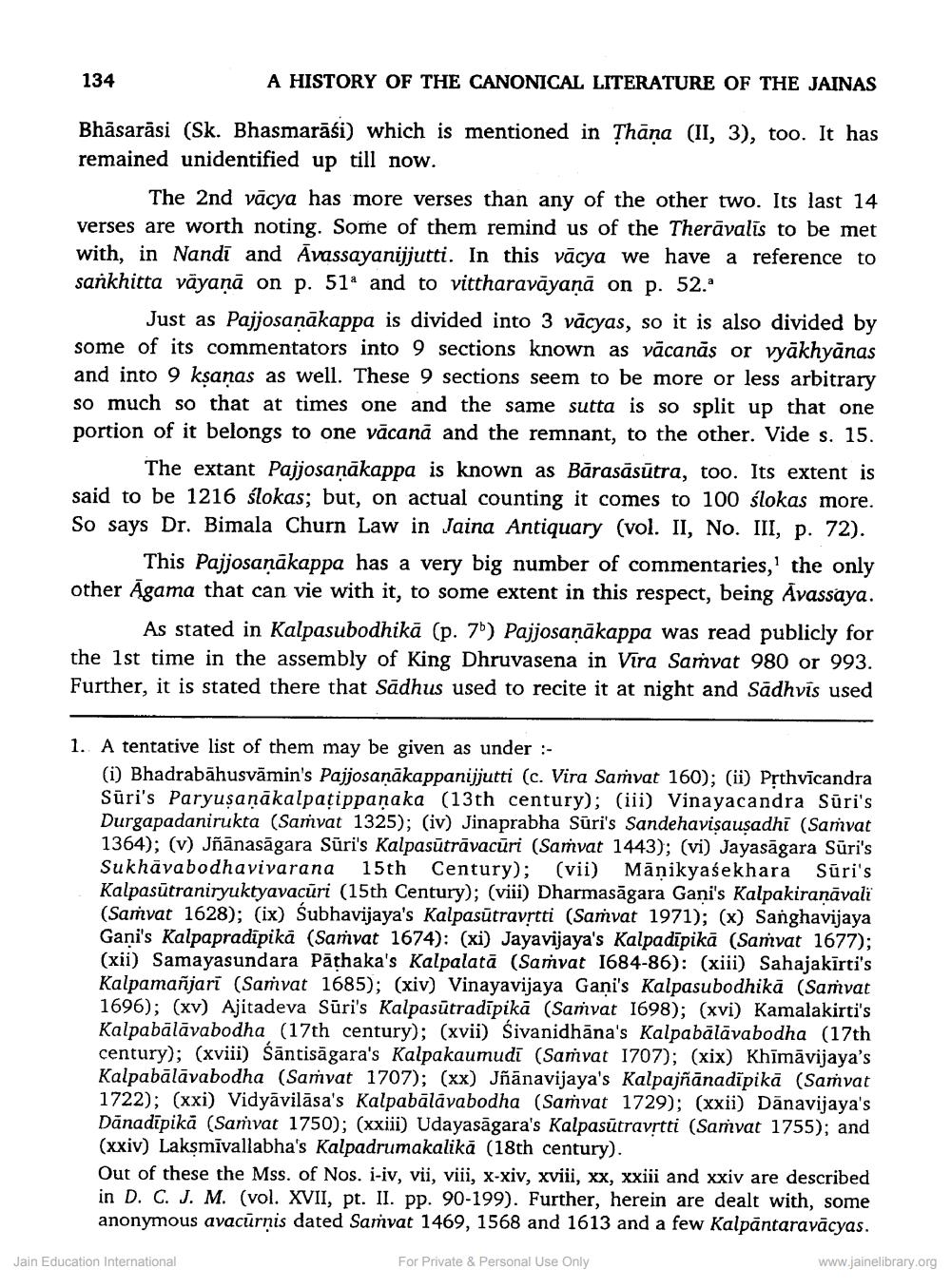________________
134
A HISTORY OF THE CANONICAL LITERATURE OF THE JAINAS
Bhāsarāsi (Sk. Bhasmarāśi) which is mentioned in Țhāna (II, 3), too. It has remained unidentified up till now.
The 2nd vācya has more verses than any of the other two. Its last 14 verses are worth noting. Some of them remind us of the Therāvalīs to be met with, in Nandi and Avassayanijjutti. In this vācya we have a reference to sankhitta vāyanā on p. 51° and to vittharavāyanā on p. 52.
Just as Paijosanākappa is divided into 3 vācyas, so it is also divided by some of its commentators into 9 sections known as vācanās or vyākhyānas and into 9 ksanas as well. These 9 sections seem to be more or less arbitrary so much so that at times one and the same sutta is so split up that one portion of it belongs to one vācan, and the remnant, to the other. Vide s. 15.
The extant Pajjosanākappa is known as Bārasāsūtra, too. Its extent is said to be 1216 ślokas; but, on actual counting it comes to 100 ślokas more. So says Dr. Bimala Churn Law in Jaina Antiquary (vol. II, No. III, p. 72).
This Pajjosaņākappa has a very big number of commentaries, the only other Agama that can vie with it, to some extent in this respect, being Avassaya.
As stated in Kalpasubodhikā (p. 76) Pajjosaņākappa was read publicly for the 1st time in the assembly of King Dhruvasena in Vira Samvat 980 or 993. Further, it is stated there that Sädhus used to recite it at night and sādhvis used
1. A tentative list of them may be given as under :
(i) Bhadrabāhusvämin's Pajjosaņākappanijjutti (c. Vira Samvat 160); (ii) Pșthvicandra Suri's Paryusaņākalpatippaņaka (13th century); (iii) Vinayacandra Sūri's Durgapadanirukta (Samvat 1325); (iv) Jinaprabha Sūri's Sandehavisausadhi (Samvat 1364); (v) Jñānasāgara Sūri's Kalpasūtrāvacūri (Saṁvat 1443); (vi) Jayasagara Sūri's Sukhāvabodhavivarana 15th Century); (vii) Mānikyasekhara Sūri's Kalpasūtraniryuktyavacūri (15th Century); (viii) Dharmasāgara Gani's Kalpakiranāvali (Saṁvat 1628); (ix) Subhavijaya's Kalpasūtravrtti (Samvat 1971); (x) Sanghavijaya Gani's Kalpapradipikā (Saṁvat 1674): (xi) Jayavijaya's Kalpadīpikā (Saṁvat 1677); (xii) Samayasundara Pāthaka's Kalpalatā (Saṁvat 1684-86): (xiii) Sahajakīrti's Kalpamañjari (Saṁvat 1685); (xiv) Vinayavijaya Gani's Kalpasubodhikā (Saṁvat 1696); (xv) Ajitadeva Sūri's Kalpasūtradīpikā (Saṁvat 1698); (xvi) Kamalakirti's Kalpabālāvabodha (17th century); (xvii) Śivanidhāna's Kalpabālāvabodha (17th century); (xviii) śāntisāgara's Kalpakaumudi (Saṁvat 1707); (xix) Khīmāvijaya's Kalpabālāvabodha (Samvat 1707); (xx) Jñānavijaya's Kalpajñānadipikā (Saṁvat 1722); (xxi) Vidyāvilāsa's Kalpabālāvabodha (Samvat 1729); (xxii) Dānavijaya's Dānadīpikā (Samvat 1750); (xxiii) Udayasāgara's Kalpasūtravrtti (Samvat 1755); and (xxiv) Laksmīvallabha's Kalpadrumakalikā (18th century). Out of these the Mss. of Nos. i-iv, vii, viii, x-xiv, xviii, xx, xxiii and xxiv are described in D. C. J. M. (vol. XVII, pt. II. pp. 90-199). Further, herein are dealt with, some anonymous avacūrnis dated Samvat 1469, 1568 and 1613 and a few Kalpantaravācyas.
Jain Education International
For Private & Personal Use Only
www.jainelibrary.org




